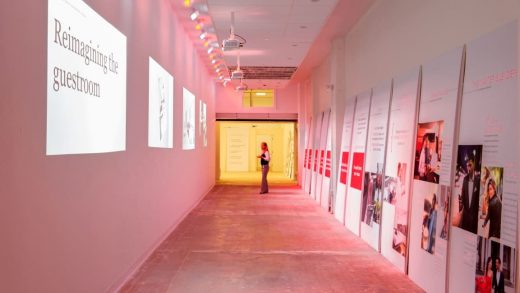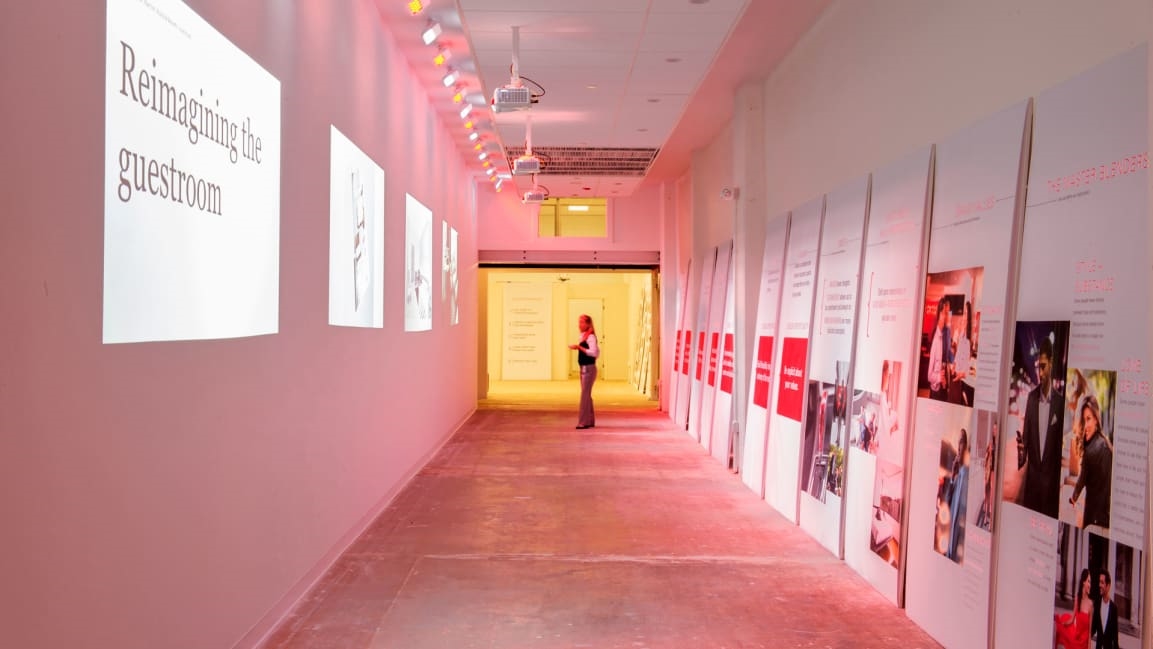Inside the secret laboratory where Marriott is cooking up the hotel of the future
As anyone who’s pulled off the interstate late at night knows, hotels like Marriott, Residence Inn, Sheraton, and Aloft are frequently neighbors, lined up side by side on the outskirts of town. It’s less usual to see them side by side in a basement in Bethesda, Maryland, though. Yet two stories below Marriott International’s sprawling headquarters, they do just that.
The Innovation Lab’s origin story goes something like this: Years ago, an employee accidentally locked himself in the basement of Marriott’s sprawling headquarters. Looking for an escape route, he poked his head through a ceiling tile and realized the space was twice as tall as he thought. “Later, he realized the potential of what he had found, and came up with the idea that started the beginning of our future,” says Aliya Khan, the company’s vice president for global design strategies.
The result of the employee’s accidental discovery of free space is the 10,000-square foot Innovation Lab–a maze of rooms, each a perfect replica of where you will eventually drop your weary head after a day on the road. “Originally we had a series of model rooms offsite, but they were quite far and proved challenging to place new product or test things out as part of an everyday design evolution,” says Khan. “In time, those model rooms moved to Marriott HQ, but it still lacked the white space in which our teams could test out innovations quickly and informally, hence the birth of the Underground!” The so-called Underground innovation lab feels a bit like a life-sized dollhouse, but it’s where designers and architects work to create the hotel room of the future across the company’s brands.
It’s a tall order, as Marriott International, the largest hotel group in the world, owns 30 brands, each with a distinct style and target demographic and a near-constant need for updates and renovations. Marriott has mapped out a challenging plan to add between 275,000 and 295,000 rooms by 2021, and each of those rooms will need a look and feel and outlets. While Marriott International’s brands are growing, adding to the estimated 1.3 million guest rooms it already has (at least according to data tracker STR), it still faces stiff competition from Airbnb, which has nearly 5 million rooms listed, according to AirDNA. To help lure customers from Airbnb, Marriott recently launched its own home-rental business, and those rooms will need to be alluringly designed to appeal to Airbnb customers, a design that will be created in the Innovation Lab.
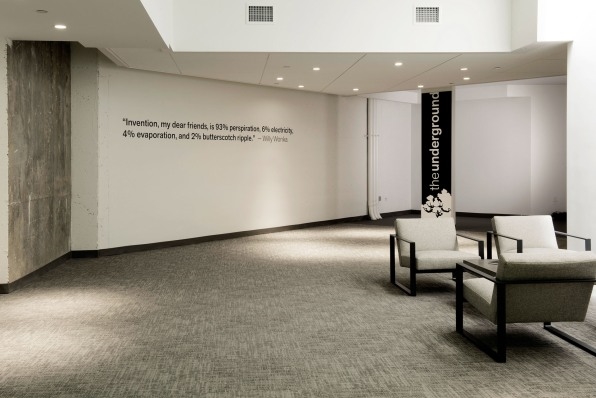
In practical terms, the Lab is a warren of rooms, each a full-sized prototype, that is the pinnacle of integrative design, where creators can step into the space and live in it, at least for a little while. “We use the innovation lab to perfect the product offered at our brands,” says Khan. “We use the lab to generate and test our ideas before going to market. This allows us to get the feedback we need prior to launching something in the field. From flooring studies to drone cocktails, to the build-out of public space, we can stretch our imagination in all directions and ensure what we deliver is relevant to our guests today and into the future.” In practice, that means the lab where her teams quickly suss out which bed frames and wall sconces and electrical outlets and chairs work best. They make sure the desks are larger–or smaller–for the needs of the guests, think about showers and bedside lamps and drawers versus closets and the positioning of the bed to the window and whether that lets in too much light, even whether the placement of a bed light ensures guests can read a book in bed.
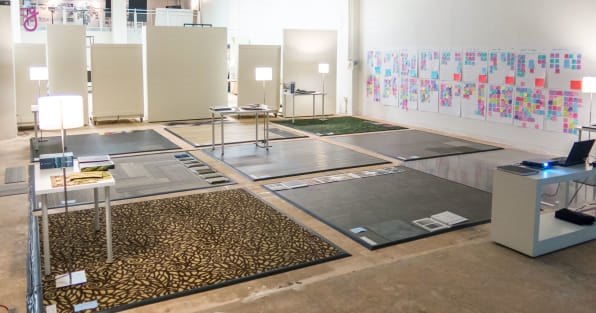
This isn’t just an interior design playground, though. The collaborative space makes it easy for, say, housekeeping to walk into the room, look around, and point out that an element would be nearly impossible to clean, or suggesting a change in layout that would make vacuuming a lot easier. Additionally, the team works closely with customer feedback to ensure that the rooms at each hotel are giving customers what they want–be it more outlets, better amenities, a place to sit that’s not the bed, or a designated place to eat a meal. While guests can’t stay there, Jeff Voris, Marriott International’s senior VP of global design strategy, admitted that he frequently comes down to work at the Springhill Suites room, enjoying the peacefulness of the dark, wood-filled sanctuary.
Each of the brands in Marriott’s vast portfolio, which became even more extensive after they purchased Starwood Hotels in 2016, offers a very distinct feel to appeal to a different traveler. One door leads to a remodeled Aloft, created for adventurous, tech-savvy types, who want a boutique hotel feel at a good price. Khan and her team have been hard at work on the brand’s refreshed look, which includes a transparent headboard, a clutter-free, loft-like feel, tongue-in-cheek retro American wallpaper (that Khan is particularly smitten with), and nods to the future in the form of a decal that is an abstraction of a motherboard, and drapes that take their pattern from binary code. Not only is the refresh relevant to today, but ideally it will be flexible enough to work for future travelers, too. Ideally, the redesign will also create rooms that are cost-efficient to buy and install, easier to renovate, and appealing to the owners of the more than 150 Aloft hotels already open today globally.
Another door leads to the chic, upscale Westin with a leaf-canopy inspired ceiling and breezy, elegant décor. Open another door and you’re in the Fairfield Suites, designed for families with a pull-out sofa, or an Element created for long-term stays with a kitchen and room to breathe. The model of the AC Hotel rooms, which have a more European feel since they were originally launched in Spain, has a proper coffeemaker with coffee you would actually drink at home. (It was Torrefazione Italia coffee when I visited.)
The rooms are very much a work in progress, with swatches of material, vision boards, lamp options, and soap and shampoo choices set up so designers can decide what works best. Ideas that are introduced to one hotel—the hip, fun Aloft brand is a bit of an incubator for the more traditional brands—and are deemed successful can be introduced to other hotels. Around every six years, hotels come up for renovation, and that’s when new design elements and new technology are introduced and the team starts the design process all over again.
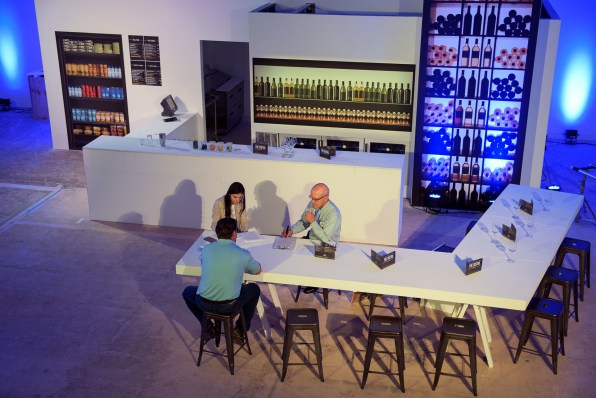
The lab lets the teams address changing styles, technology, and service on a small scale before taking it global and realizing far too late that, say, there is no outlet for charging your phone near the bed, or that the only light switches in a room are by the front door, an aggravating experience that is all too familiar to most travelers.
A long hallway, which serves as an oversized ideas board and ersatz gallery, thanks to projected images and a high-performance LED lighting system, leads to a warehouse-like space that is designed to be a blank slate. It’s a bit like Harry Potter’s Room of Requirement in that it can be adapted for any purpose. On a recent visit, there were paperboard-and-duct-tape showers in one corner, created by designers so they could test sizes. Another section had a full room laid out in what looked like oversized LEGO bricks so that architects could determine how small the room could be and still function (the hotel room of the future is very small, apparently). There were sink options installed along one wall, couches and coffee tables set up in the middle as an ersatz test of potential pairings, and a secret project set up in the middle under lock and keyless entry. (I’ll just say it’s very, very cool.) Also on display was the lab’s virtual reality set-up where earlier that day CEO Arne Sorenson took a virtual tour through a few room designs.
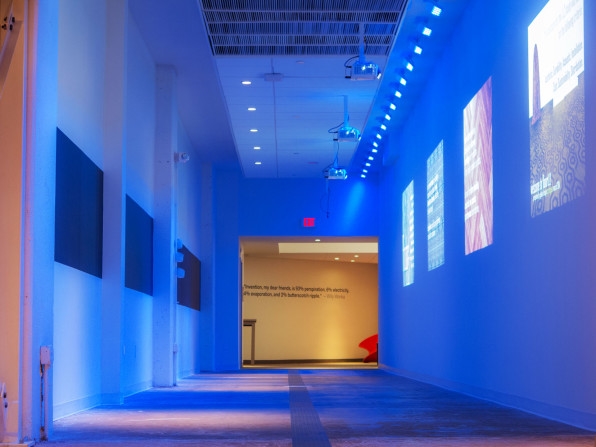
The lab isn’t the only place where innovation takes place, of course. In a parking lot outside of Marriott HQ is a shipping container that holds an entire Moxy Hotel room, which they sent across country to try and find franchise owners for the brand at the ALIS hotel investment conference. They also set up a pop-up innovation lab in Los Angeles in 2017, allowing guests to provide real-time feedback as they showed off the redesigned communal living spaces at the long-stay hotel Element and the robot butler from their tech-forward brand Aloft. In 2016, it unveiled its first M Beta hotel, the world’s first hotel in “live beta,” which functions as both a hotel and innovation lab with the hope of being ready for Gen Z visitors. (Fast Company wrote about it in 2016.)
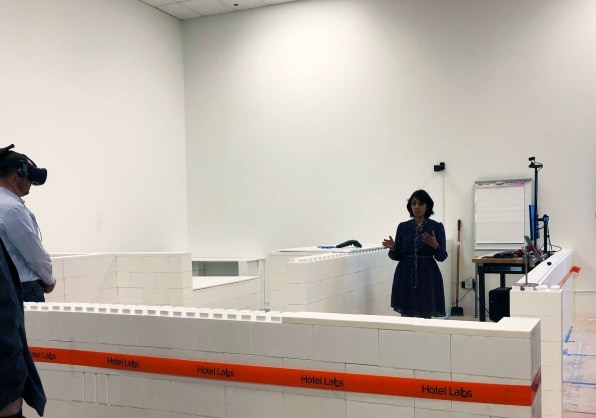
Marriott isn’t the only hotel group to have its own free-standing innovation lab. Hilton has a brand-new Innovation Gallery next to its headquarters in Virginia, just around the beltway from Marriott’s HQ. Swissotel has a design lab with full-size replica rooms and lobbies to show off their design ideas. The Peninsula Hotels creates all its own technology in-house at their Research & Technology Department, Hyatt will turn any property into a test property to test their innovations, and AccorHotels has a “Disruption & Growth Department” to come up with new ideas for their properties. The proliferation of such labs is a sign of how crowded the hospitality market has become. Innovation, reinvention, and technology are a few ways that hotels can try to elbow each other out of the way to vie for customers and try to fight off the threat of Airbnb, Sonder, and the like.
At Marriott, the innovation lab lies at the heart of the work they do to differentiate their 30 different brands. The lab is designed to be a template for innovation and collaboration, as enshrined in a quote from Willy Wonka written on the wall near the lab’s entrance, “Invention, my dear friends, is 93% perspiration, 6% electricity, 4% evaporation, and 2% butterscotch ripple.” While (sadly) there was no butterscotch ripple in sight, there was definitely evidence of a lot of hard work.
(53)

